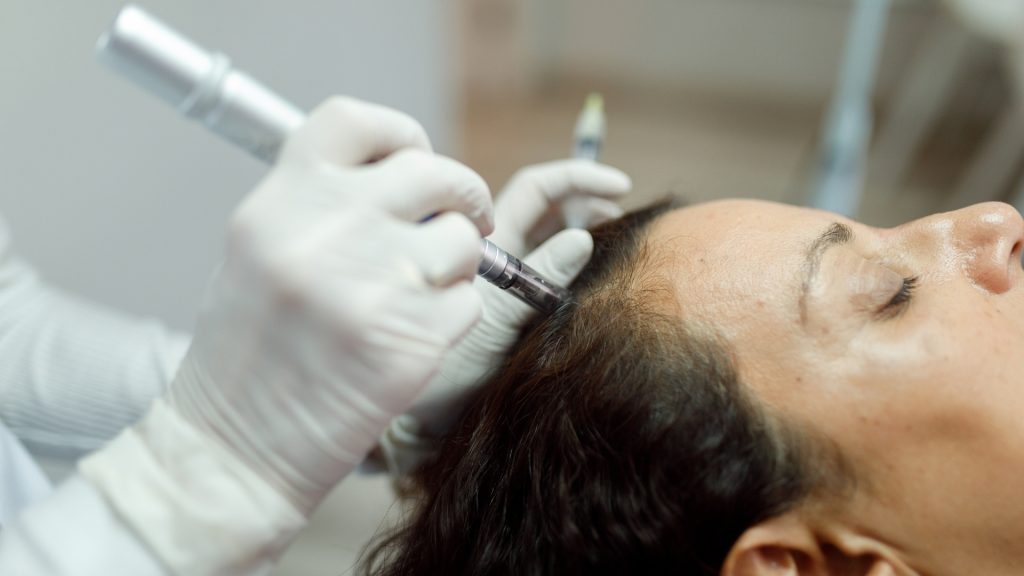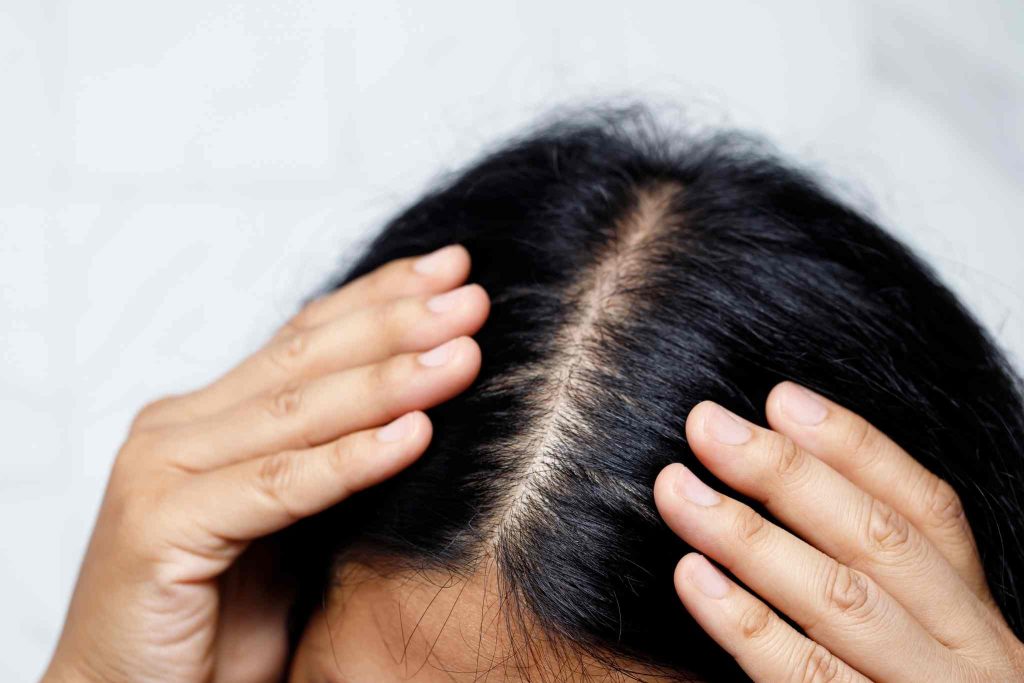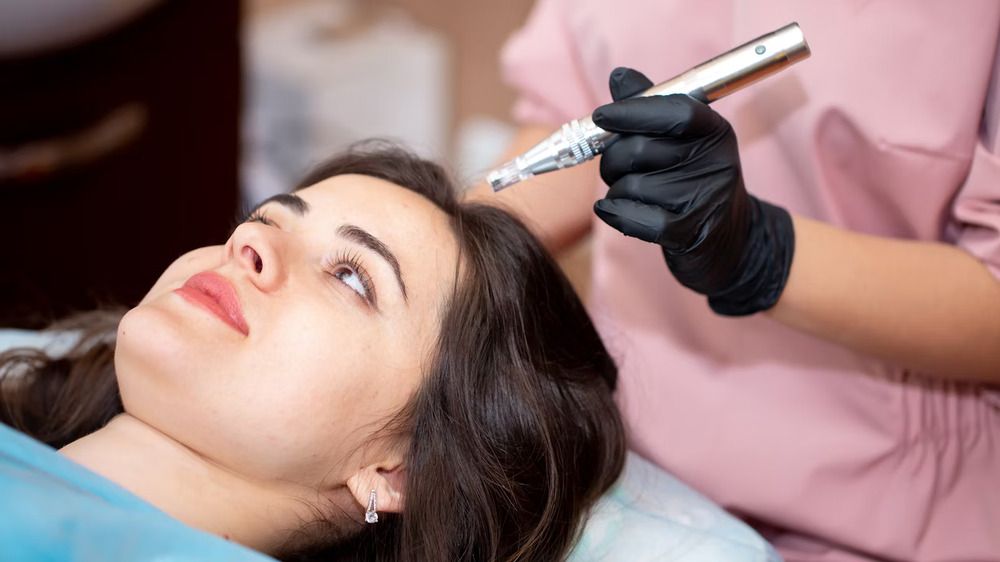
Hair loss affects millions of individuals worldwide, leading many to explore emerging solutions beyond traditional treatments. Among the latest methods generating attention is microneedling for hair growth, a procedure once limited to skin rejuvenation but now gaining popularity for its potential impact on the scalp. While its cosmetic benefits for wrinkles and scars are well-known, many wonder: Does microneedling help with hair growth?
Understanding how this technique works and why it’s gaining traction can help determine if it’s a viable option for those dealing with thinning hair.
Table of Contents
What Is Microneedling and How Does It Work?
How Does Microneedling Work for Hair Growth?
Does Microneedling Help With Hair Growth on Its Own?
Why Choose Microneedling Over Other Methods?
Microneedling Procedure: What to Expect
Who Is a Good Candidate for Microneedling for Hair Growth?
Combining Microneedling With Other Therapies
How to Choose a Healthcare Provider for Microneedling
- Medical Credentials
- Specialization in Hair Loss Treatment
- Use of Professional-Grade Equipment
- Treatment Environment and Cleanliness
- Consultation Process
- Transparency About Results and Limitations
- Patient Reviews and Testimonials
- Post-Treatment Support
- Integration with Other Therapies
Start Your Hair Regrowth Journey with BioRestore!
| Key Takeaways
✔Microneedling activates the body’s natural healing response, releasing growth factors that stimulate hair follicle activity. ✔ The procedure improves scalp blood circulation, helping deliver more oxygen and nutrients to dormant hair follicles. ✔ Microneedling may trigger stem cell activity in the hair follicle base, which can initiate the growth phase of the hair cycle. ✔ By increasing collagen production, microneedling helps strengthen the scalp and support healthier hair structure. ✔ Microneedling creates micro-channels in the scalp that allow topicals like minoxidil and peptides to absorb more deeply and effectively. ✔ When topicals are applied after microneedling, they become more potent due to better absorption during the scalp’s healing phase. |
What Is Microneedling and How Does It Work?
Microneedling is a minimally invasive dermatological technique that uses fine, sterile needles to create controlled micro-injuries in the skin. This process stimulates the body’s natural healing response, increasing the production of collagen, elastin, and new skin cells. On the scalp, this same mechanism targets the areas surrounding hair follicles, promoting regeneration and better follicular health.
How Does Microneedling Work for Hair Growth?
The scalp responds to microneedling through several biological processes that explain how microneedling helps hair growth and supports hair regrowth:
- Wound Healing Activation: Microneedling triggers the body’s innate repair system. As the skin heals, it releases growth factors like platelet-derived growth factor (PDGF) and epidermal growth factor (EGF), both of which are essential in promoting hair follicle activity.
- Increased Blood Flow: The micro-injuries improve local circulation, which brings more oxygen and nutrients to hair follicles. Enhanced blood supply is key in nourishing dormant follicles and reactivating their growth cycles.
- Stimulation of Stem Cells: The process may activate dermal papilla cells, which are located at the base of the hair follicle. These stem-like cells are crucial for initiating the anagen (growth) phase of the hair cycle.
- Enhanced Collagen Remodeling: Collagen supports the structure of the scalp. Improved collagen density around the follicles can create a stronger foundation for new hair strands and improve overall scalp health.
Does Microneedling Help With Hair Growth on Its Own?
For many individuals, microneedling for hair growth can be a stand-alone solution or the foundation of a more comprehensive hair restoration protocol. While combination therapies often deliver faster and more visible results, microneedling alone has demonstrated effectiveness in:
- Stimulating early-stage follicular regrowth
- Thickening existing hair strands
- Slowing hair thinning when performed consistently
Why Choose Microneedling Over Other Methods?
For individuals looking for non-surgical, low-risk solutions, microneedling for hair growth is gaining attention as a safe and effective option. Microneedling has shown greater effectiveness in treating alopecia compared to traditional pharmaceutical delivery methods.
- Minimally Invasive: No incisions, no downtime, and fewer risks than surgical interventions like hair transplants.
- Drug-Free Alternative: Beneficial for individuals who prefer to avoid or cannot tolerate medications like finasteride or minoxidil.
- Can Be Used in Combination: Works synergistically with other therapies, like PRP or topical agents, for enhanced results.
- Scalable and Customizable: Treatment plans can be tailored in terms of needle depth, frequency, and combination with other approaches.
Microneedling Procedure: What to Expect
Before beginning microneedling for hair growth, patients typically undergo a professional consultation to determine how does microneedling help hair growth in their specific case. This ensures the treatment is tailored to the individual’s hair loss pattern and scalp condition.
Pre-Treatment Process
- Scalp Assessment: The provider evaluates the scalp for inflammation, infection, or any contraindications to ensure safe treatment.
- Cleansing and Preparation: The scalp is thoroughly cleaned to remove oils, dead skin, and product buildup. This helps reduce the risk of infection and ensures optimal device performance.
- Application of Numbing Cream: A topical anesthetic is applied to minimize discomfort during the procedure. This is especially helpful in sensitive or balding areas.
During the Microneedling Session
- Use of Specialized Devices: A microneedling pen or roller is used to create evenly spaced micro-injuries across the treatment area. The depth of needle penetration is adjusted based on scalp thickness and treatment goals.
- Treatment Duration: Sessions typically last 30 to 60 minutes, depending on the size of the area being treated and whether topical agents like PRP or growth serums are applied.
- Targeted Coverage: Providers focus on thinning or dormant regions, often using multiple passes in problem areas to enhance stimulation.
Post-Procedure Enhancements
- Topical Applications: After microneedling, the scalp becomes highly receptive. This is the ideal time to apply treatments such as:
- Minoxidil – Increases follicle activity.
- Growth Serums – Deliver peptides and vitamins directly to the follicular zone.
- PRP Therapy – Injected or massaged into the scalp to further stimulate follicle regeneration.
Common Side Effects
- Redness and Sensitivity: Temporary inflammation is common and typically fades within 24 to 48 hours.
- Swelling or Flaking: Mild swelling or scalp dryness may occur, particularly after deeper needling or combination treatments.
- Avoidance Guidelines: Patients are usually advised to avoid sun exposure, hair washing, or harsh products for 24 hours post-treatment to minimize irritation.
Expected Timeline for Results
- Delayed but Gradual Improvement: Results are not immediate. Since hair follicles take time to cycle, new growth typically begins to appear within 3 to 6 months.
- Session Frequency: For optimal results, most patients undergo treatments every 2 to 4 weeks in the early stages. With a gradual reduction in frequency once regrowth is established.
- Cumulative Benefits: Repeated sessions are essential, as each builds upon the last, reinforcing cellular regeneration and follicle activation.

Who Is a Good Candidate for Microneedling for Hair Growth?
Microneedling is not a one-size-fits-all solution. Its effectiveness depends on the individual’s scalp condition, the cause of hair loss, and the timing of the intervention. Understanding who benefits most can help set realistic expectations.
Ideal Candidates
These individuals are most likely to experience positive results from microneedling for hair growth:
- Early-Stage Hair Thinning: Those who notice increased shedding, receding hairlines, or decreased hair density may benefit when follicles are still active but weakened.
- Mild to Moderate Androgenetic Alopecia: Men and women with hereditary hair thinning (pattern baldness) are often good responders. Microneedling may help delay progression and support regrowth in early-affected areas.
- Individuals with Slow Hair Growth: People who experience stagnant or delayed regrowth following shedding or seasonal hair loss may see a boost in follicular activity.
- Patients Using Topical Treatments: Those already using minoxidil, peptides, or PRP may experience improved results, as microneedling enhances product absorption and delivery.
- Healthy Scalp Environment: A clean, intact, and well-moisturized scalp provides the best foundation for safe microneedling and optimal outcomes.
Who Should Avoid Microneedling?
Some individuals may face complications or reduced effectiveness due to underlying conditions. Treatment should be avoided or delayed for the following:
- Active Scalp Infections: Bacterial or fungal infections can worsen if microneedling is performed on inflamed or compromised skin.
- Chronic Scalp Conditions (Psoriasis, Eczema): These disorders can flare with physical trauma, potentially leading to increased irritation, flaking, or scarring.
- Bleeding or Clotting Disorders: Individuals with these conditions face a higher risk of excessive bleeding or bruising during treatment.
- History of Keloid Scarring: Those prone to abnormal scar formation may develop raised scars where needles were applied.
- Recent Hair Transplants or Open Wounds: Healing tissues should not be disturbed, and microneedling should be postponed until full recovery.
Why Consultation Matters
- Personalized Assessment: A healthcare provider evaluates scalp condition, hair loss type, and history to determine if microneedling for hair growth is appropriate.
- Custom Treatment Plans: Depending on individual needs, they will decide needle length, treatment frequency, and whether to pair microneedling with other therapies.
- Safety First: Only a qualified professional can ensure that microneedling is performed correctly, especially when deeper needle penetration is required.
Combining Microneedling With Other Therapies
Microneedling is often more effective when used in combination with other hair restoration methods. The reason microneedling helps with hair growth more effectively when combined is due to how it enhances both penetration and performance of other therapies.
Why Combine Therapies With Microneedling?
- Improves Efficacy of Topicals: The micro-channels formed by microneedling allow ingredients in serums and medications to penetrate deeply into the scalp. This increases absorption and helps the active compounds reach the hair follicle base, where they are most needed.
- Amplifies Cellular Response: Microneedling stimulates natural healing. When followed with supportive treatments, the regeneration process is intensified, helping improve follicle function and promoting regrowth.
- Targets Multiple Causes of Hair Loss: Hair thinning is rarely caused by one factor alone. A combination approach-using microneedling to open pathways and other therapies to address hormonal, nutritional, or inflammatory issues-delivers a more comprehensive solution.
Commonly Combined Therapies
- Minoxidil (Topical Hair Growth Medication): When applied after microneedling, minoxidil can penetrate the scalp more effectively. A 2025 meta-analysis found that combining microneedling with topical minoxidil significantly increased hair count compared to minoxidil alone. The standardized mean difference was 1.32 (95% CI 0.73-1.92, p < 0.01), indicating a substantial improvement in hair regrowth.
- PRP (Platelet-Rich Plasma) Therapy: PRP uses a patient’s own plasma, rich in growth factors, to support tissue healing and follicle stimulation. Administering PRP after microneedling allows it to enter the scalp through the newly formed micro-injuries, significantly enhancing its regenerative effects. This combination is frequently used in medical hair clinics for more advanced cases of hair thinning.
- Topical Peptides and Growth Factor Serums: These products contain biologically active molecules that promote cell signaling and protein synthesis in hair follicles. When used after microneedling, these compounds can be absorbed more efficiently, helping improve hair texture, strength, and thickness over time.
- Natural Oils and Botanical Extracts: Ingredients like rosemary oil and caffeine-based solutions may benefit from deeper scalp delivery. When applied post-treatment, they may reduce inflammation and support healthier follicle function. While not as potent as pharmaceutical agents, these natural options are popular in holistic treatment plans.
How to Choose a Healthcare Provider for Microneedling
Selecting the right professional is essential when undergoing microneedling for hair growth. The safety, effectiveness, and overall outcome of the procedure depend heavily on the qualifications and practices of the provider. Here are some factors to consider:
1. Medical Credentials
Always ensure the provider is medically certified. Dermatologists, trichologists, or aesthetic medical professionals with training in scalp care and hair restoration are best qualified to perform microneedling procedures safely and effectively.
2. Specialization in Hair Loss Treatment
It’s not enough to offer microneedling. The provider should demonstrate a clear understanding of how does microneedling help hair growth and have a track record of treating various types of hair loss. They should also be able to tailor the technique based on individual scalp health, hair density, and progression of thinning.
3. Use of Professional-Grade Equipment
Ask what kind of microneedling devices the provider uses. Top-tier clinics use FDA-cleared, adjustable-needle depth devices designed for scalp penetration. These tools provide consistent puncture control, reduce the risk of injury, and improve treatment accuracy.
4. Treatment Environment and Cleanliness
A clean, sterile setting is non-negotiable. The risk of infection increases significantly if proper sanitation is not maintained. Ensure that disposable needles, gloves, and other supplies are used, and that all surfaces are disinfected between sessions.
5. Consultation Process
A reputable provider should begin with a comprehensive consultation. This includes reviewing your hair loss history, performing a scalp analysis, and determining if you’re a good candidate. The provider should explain how does microneedling work for hair growth in your specific case and whether it should be paired with other treatments.
6. Transparency About Results and Limitations
Beware of exaggerated promises. A responsible provider will set realistic expectations about the timeline, number of sessions required, and the degree of improvement likely to be achieved. They should explain both the potential benefits and limitations of the treatment.
7. Patient Reviews and Testimonials
Online feedback from previous patients can offer insights into the provider’s skill, professionalism, and quality of care. Look for before-and-after photos, satisfaction ratings, and reviews that mention long-term follow-up.
8. Post-Treatment Support
Aftercare guidance is critical for optimal results. A good provider will give detailed instructions on scalp care, activity restrictions, and product use after each session. This shows a commitment to the patient’s full treatment journey, not just the in-office procedure.
9. Integration with Other Therapies
Providers who understand advanced hair restoration often combine microneedling with topical agents, PRP, or other treatments. They should be able to explain how these therapies work together and customize a multi-modal plan to suit your needs.
Frequently Asked Questions
Yes, microneedling has been shown to stimulate hair regrowth by activating the body’s natural healing processes and improving blood flow to hair follicles. It also enhances the absorption of topical treatments, making them more effective. Results vary, but many people see noticeable improvements after consistent treatment.
Microneedling is typically recommended every 2 to 4 weeks, depending on the individual’s scalp condition and treatment goals. Frequent sessions help maintain stimulation of hair follicles without overwhelming the skin’s healing cycle. A healthcare provider can adjust the schedule for best results.
Common side effects include redness, tenderness, and mild swelling for 1–2 days post-treatment. If performed incorrectly or with unsterile equipment, there’s a risk of infection or scarring. It may also worsen certain scalp conditions like eczema or psoriasis.
Clinical studies show success rates ranging from 60% to 80% in promoting visible hair regrowth, especially when combined with treatments like minoxidil or PRP. Individual results depend on the cause of hair loss, consistency, and overall scalp health. Early intervention generally leads to better outcomes.
New hair growth usually begins to appear 3 to 6 months after starting microneedling treatments. This delay is due to the natural hair growth cycle and gradual follicle activation. Full results typically require multiple sessions and long-term consistency.

Start Your Hair Regrowth Journey with BioRestore!
If you’re ready to experience fuller, healthier hair, now is the time to take action. BioRestore offers professional microneedling treatments tailored to your unique hair loss needs, combining science-backed techniques with personalized care. BioRestore in Connecticut is equipped with advanced technology and experienced specialists dedicated to your success. Residents across Connecticut trust BioRestore for safe, effective microneedling for hair growth.
Book your consultation today with BioRestore and see how targeted scalp therapy can bring new life to your hair!